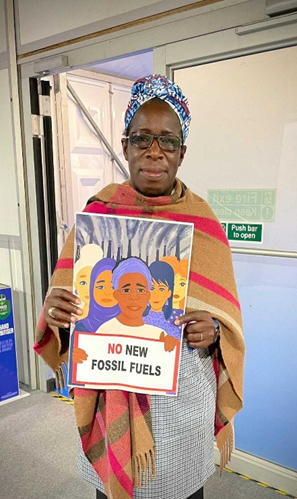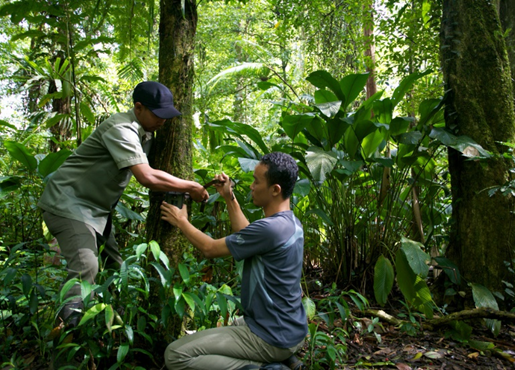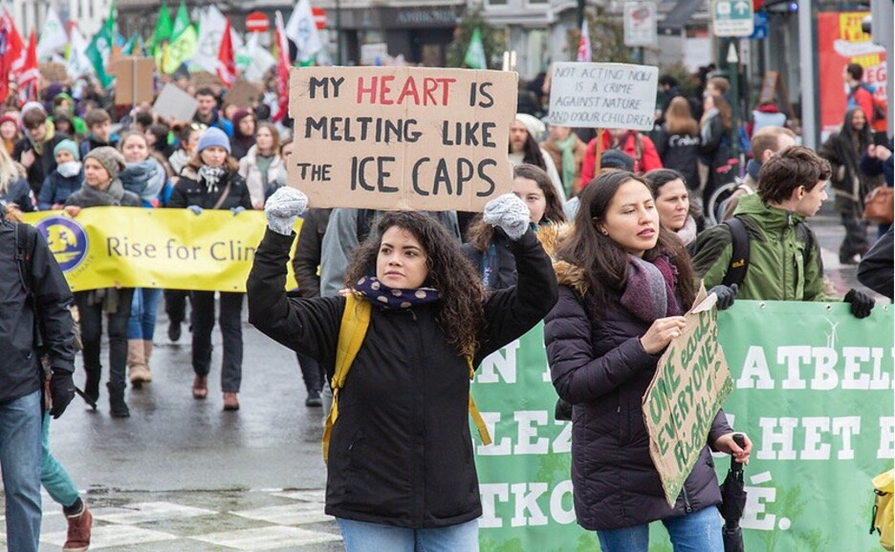The Climate Crisis in Healthcare
Eliora Amadasun • 2024-07-03
Climate change, characterised by long-term alterations in temperatures and weather patterns, directly catalyses humanitarian crises.
Climate Change is driven primarily by human activities like the combustion of fossil fuels, which pose as a fundamental threat to human health and natural systems. Furthermore, it exacerbates existing health challenges and intensifies extreme weather events such as storms, heatwaves, floods, droughts, and wildfires. These events directly and indirectly endanger human health by escalating mortality rates, worsening noncommunicable diseases, facilitating the spread of infectious diseases, and triggering health emergencies. Given these impacts, the link to medicine is clear; climate change significantly affects human health and burdens healthcare systems. Recognising these interconnections is crucial for developing effective strategies to protect public health in the face of a changing climate. The link between Climate Change and Public Health
Health, as defined by the World Health Organization, is a state of complete physical, mental, and social well-being, not merely the absence of disease or infirmity. This comprehensive understanding of health lays the groundwork for comprehending the profound impact of climate change on human well-being because it emphasises the interconnectedness of various aspects of human wellness. By recognising that health encompasses not only physical health but also mental and social well-being, we understand that climate change affects the entirety of human health, not just isolated components. This holistic perspective highlights the urgency of addressing climate change to safeguard the health and well-being of individuals and communities worldwide.
Physical Health Impacts:
- Heat-related Illness
Heat can have various adverse effects on health. More frequent and intense heatwaves due to rising temperatures could lead to a dramatic increase in heat-related deaths. The UK Health Security Agency stated that, “By the 2070s, under a high-warming scenario without adaptation, the UK could see over 21,000 additional heat-related deaths annually”. Although the climate is warming, an increase in deaths from cold is also anticipated, primarily due to an aging population. When temperatures rise and we have more intense heatwaves, it can cause health problems like heatstroke, exhaustion, cramps, and rashes. These problems can be severe or even fatal. Vulnerable populations, including infants, young children, older adults, outdoor workers, and individuals with pre-existing medical conditions, are particularly susceptible to these heat-related health effects. However, heatwaves can adversely affect anyone by pushing the body beyond its capacity for temperature regulation. As climate change continues to accelerate, the incidence of heat-related hospitalisations and fatalities is projected to rise significantly.
2. Air Quality Decline: Understanding the impact through the case of Ella Adoo-Kissi Debrah
Air quality decline refers to the deterioration of the purity and cleanliness of the air in a particular environment. Over the last two decades, there has been a reduction in air pollution emissions, leading to improved air quality. However, despite this progress, air pollution remains the largest environmental health risk in Europe
When evaluating those most vulnerable to health issues from air pollution, certain groups stand out as especially at risk:
• Individuals with pre-existing lung diseases like asthma are especially at risk, facing worsened symptoms and respiratory complications when exposed to polluted air
• Infants and young children, whose respiratory systems are still developing, are also more prone to infections and long-term respiratory issues.
• People who work or exercise outside, as well as those living near busy roads, are exposed to higher levels of pollutants, leading to increased respiratory symptoms and cardiovascular effects. Older adults over 65 and those with existing heart conditions are at greater risk of adverse cardiovascular outcomes like heart attacks and strokes from polluted air.
• Socioeconomically disadvantaged groups, including those in poverty without proper healthcare access, bear a disproportionate burden of air pollution-related health issues due to factors like poor housing and limited medical resources. Smokers and those exposed to second-hand smoke, face compounded health risks when exposed to air pollution, also worsening respiratory and cardiovascular diseases.
• Lastly, certain job sectors, such as workers in factories, construction sites, or coal mines, often experience higher levels of air pollution exposure due to the nature of their work environments. This in turn leads to an increased risk of respiratory and cardiovascular issues due to prolonged exposure to workplace pollutants.
As now currently comprehended, exposure to polluted air can lead to various health problems. However, there's a distinction between different pollutants, each causing distinct issues. The different pollutants are characterised by fine particle pollution and ground-level ozone pollution:
• Fine particle pollution, mainly composed of particles smaller than 2.5 micrometres, has the ability to penetrate deep into the lungs and bloodstream. This can worsen respiratory conditions such as asthma, chronic bronchitis, and emphysema, along with cardiovascular diseases like heart attacks and strokes. Additionally, fine particle pollution is linked to adverse birth outcomes and premature death. Symptoms of fine particle pollution exposure may include shortness of breath, wheezing, coughing, chest pain, and fatigue.
• Ground-level ozone, a significant component of smog, primarily impacts the respiratory system by causing inflammation and irritation of the airways. This worsens respiratory conditions such as asthma and chronic obstructive pulmonary disease (COPD), resulting in symptoms like coughing, wheezing, and shortness of breath. Prolonged exposure to ground-level ozone can also lead to a decline in lung function and heightened susceptibility to respiratory infections. Symptoms of ground-level ozone pollution may include difficulty breathing deeply, sore throat, coughing, wheezing, and fatigue.
The severity of air pollution is often underestimated by many; Air pollution can cause morbidity:
In countries within the European Economic Area (EEA) and those that work with them, air pollution is estimated to cause over 1,200 deaths each year in people under the age of 18. This means that many children and teenagers are dying prematurely due to exposure of polluted air.
In 2021, this issue was highlighted by the fact that chronic exposure to fine particulate matter, and nitrogen dioxide levels surpassing World Health Organization recommendations, led to 253,000 premature deaths, with an additional 52,000 attributed to nitrogen dioxide, and 22,000 to acute ozone exposure.
In light of these alarming statistics, the case of Ella Adoo Kissi Debrah serves as a stark reminder of the dire consequences of air pollution on human health:
Let’s begin by affirming: Access to clean air is a fundamental human right. Clean air is not merely a luxury but a necessity for maintaining good health and well-being. It is essential for breathing freely without the risk of harmful pollutants damaging our respiratory systems. However, for many individuals and communities, this right remains elusive due to various factors such as industrial pollution, vehicle emissions, and inadequate environmental regulations.
Ella Adoo Kissi Debrah, born in 2004 at Lewisham Hospital, Southeast London, was a vibrant and active child. She loved swimming, gymnastics, reading, music, and much more. Dreaming of becoming an air ambulance doctor, she was inspired by the Red Arrows. However, at age seven, she developed asthma, leading to severe health challenges. Despite numerous medical tests, her condition remained unclear. On February 15, 2013, just after her ninth birthday, Ella died from a fatal asthma attack. Her passing marked a historic milestone, as she became the first individual in the UK to have air pollution cited as the cause of death on her official death certificate.
At the conclusion of a two-week inquest, coroner Philip Barlow at Southwark Coroner’s Court found that air pollution “made a material contribution” to Ella’s death. This landmark decision garnered significant attention due to its unprecedented nature. Ella resided near South Circular Road in Lewisham, south-east London. The South Circular Road is notably one of the busiest roads in the capital, characterised by heavy traffic flow and consequently elevated levels of air pollution. Prof Gavin Shaddick, a government adviser on air pollution, emphasised the significance of the coroner’s decision, recognising it as a pivotal moment in understanding the adverse health effects of air pollution. The inquest revealed distressing details about Ella’s health struggles in the years leading up to her death, including multiple seizures and frequent hospital admissions. Mr Barlow highlighted that levels of nitrogen dioxide (NO2) near Ella’s home exceeded both World Health Organization and European Union guidelines, indicating a failure to mitigate pollution levels in the area. Towards the end of his detailed conclusion, spanning nearly an hour, Mr Barlow unequivocally stated that Ella’s death resulted from asthma, exacerbated by prolonged exposure to excessive air pollution- a verdict that carries significant implications for public health policies and regulatory measures concerning air quality standards.
Rosamund Adoo-Kissi-Debrah, Ella’s mother, has since become a staunch advocate for clean air. She tirelessly calls on the government to act on the coroner's recommendations and emphasises that children are needlessly losing their lives due to insufficient action against air pollution. In response to the tragedy of Ella's death, Rosamund also established The Ella Roberta Foundation, a non-profit organisation dedicated to raising awareness about the dangers of air pollution and advocating for policy changes to mitigate its impact. The foundation works tirelessly to amplify the voices of those affected by air pollution, championing the rights of individuals to breathe clean air and live healthy lives. Additionally, Rosamund draws attention to the critical lack of information available to parents regarding the risks of air pollution and the necessary steps to protect their children’s health. She stresses that addressing this informational gap is vital in preventing similar tragedies in the future.
Professor Stephen Holgate, a leading expert on asthma and air pollution who testified at Ella's inquest, highlighted the gravity of the situation. He likened the air pollution crisis to water poisoning, a scenario that would undoubtedly spark public outrage and immediate action. Despite the UK government’s acknowledgement that long-term exposure to air pollution contributes to up to 30,000 deaths annually, direct links to individual deaths-like Ella’s case-are rarely established.
The Environment Bill, currently debated in Parliament, aims to set new targets for air pollution. Rosamund Adoo-Kissi-Debrah and health advocates urge immediate action, not only to align legal limits with WHO guidelines but also to implement measures that can protect the most vulnerable. They stress that delaying these actions means more lives, like Ella's, will be lost unnecessarily to toxic air.
At the forefront of this advocacy is Ella's Law. The law seeks to enforce stricter regulations on air pollution levels, mandating reductions in harmful emissions to safeguard public health. Additionally, it aims to ensure greater transparency regarding air quality data and empower communities to take proactive measures to reduce their exposure to pollutants. As we confront the realities of air pollution's deadly toll, it becomes imperative for policymakers to prioritise public health and enact robust measures to ensure cleaner air for all.
3. Extreme weather: Injuries and Fatalities
Extreme weather events intensified by climate change, such as hurricanes, floods, and wildfires, present a myriad of direct threats to public health. These threats encompass the risk of drowning, trauma from debris or structural damage, severe burns, smoke inhalation leading to respiratory issues, displacement of populations due to destroyed homes or infrastructure, and the disruption or destruction of healthcare facilities, hindering access to medical care during emergencies.
The science is clear- climate change is increasing the frequency and severity of extreme weather. This elevates risks to life and health when these disasters occur. Statistical data from the past five years underscores this concerning trend. Despite a 22% decrease in weather-related deaths and a 16% reduction in injuries from 2018, the number of weather events has surged by 11%. In 2022 alone, a staggering total of 69,473 weather events were recorded, resulting in 813 deaths and 1,718 injuries. Notably, specific types of extreme weather events have proven to be particularly deadly: Heatwaves, winter weather, floods, and hurricanes emerged as the primary culprits behind the most fatalities in 2022. Some significant instances include the devastating winter weather of 2021, the prolonged drought and heatwave experienced in the same year, and the catastrophic impact of Hurricane Ian in 2022. These occurrences underscore the critical importance of implementing effective strategies to mitigate climate change and its repercussions on healthcare.
Extreme weather events can also make it harder for people to get the care they need. This leaves marginalised communities, who often lack access to adequate healthcare and live in areas more vulnerable to climate-related disasters, particularly susceptible to severe infections.
As a suggestion, prioritising investments in early warning systems and disaster preparedness measures is crucial for shielding vulnerable populations from the escalating risks linked to climate change-related disasters. Additionally, advocating for the advancement of community resilience and adaptation efforts can significantly diminish the health risks associated with these disasters. Through the implementation of these strategies, communities can better prepare for and respond to extreme weather events, ultimately reducing the adverse health effects of climate change and fostering greater resilience in the face of environmental challenges.
4. Infectious Disease Risks
Climate change is anticipated to profoundly reshape the dynamics of infectious diseases, affecting their transmission patterns, geographical distribution, and seasonal occurrence. As temperatures rise, disease-carrying vectors such as mosquitoes and ticks find increasingly hospitable environments to expand their territories into new areas. Consequently, diseases spread by these vectors, such as Lyme disease, West Nile virus, and Zika, are spreading further due to climate change. The continued warming may also make malaria, dengue fever, and chikungunya even more widespread in the future. Additionally, higher temperatures encourage the development of pathogens that prefer warmer climates, weakening human immune systems and creating new health challenges.
Shifting precipitation patterns can have significant implications for public health, leading to an increase in water-borne illnesses. Changes in rainfall distribution and intensity can alter the quality and availability of water sources, potentially contaminating them with harmful pathogens and pollutants. This can contribute to outbreaks of diseases such as cholera, typhoid fever, and gastrointestinal infections, which are transmitted through contaminated water.
As noted earlier, severe weather events can have devastating effects on communities. These events can displace populations, damage infrastructure, and disrupt essential services such as sanitation and clean water supply. In the aftermath of such disasters, there is an increased risk of disease outbreaks due to compromised hygiene conditions, overcrowding in shelters, and limited access to healthcare facilities. Disrupted ecosystems, another consequence of climate change, can also play a role in triggering disease outbreaks. Alterations in natural habitats, deforestation, and habitat fragmentation can disrupt the balance of ecosystems, leading to changes in the distribution and behaviour of wildlife species. This can bring humans into closer contact with disease reservoirs and vectors, increasing the likelihood of zoonotic spill over events and the transmission of infectious diseases from animals to humans.
The encroachment of human activity into wildlife habitats refers to the expansion of human settlements, agriculture, and other forms of development into natural areas where wildlife resides. This process disrupts ecosystems and brings humans into closer contact with wild animals, increasing the likelihood of spillover events. In these events, pathogens, which are typically carried by animals, can jump species barriers, and infect humans. This phenomenon is known as zoonotic transmission. As human activities encroach further into wildlife habitats, the risk of encountering novel infectious diseases grows. Recent outbreaks like MERS (Middle East Respiratory Syndrome) and COVID-19 serve as stark examples of this risk. These diseases originated in animals before jumping to humans, highlighting the potential consequences of human-wildlife interaction.
5. Challenges in Food and Water Security
Food and water security refers to the availability and accessibility of sufficient, safe, and nutritious food and clean water to meet the dietary and hydration needs of individuals and communities for an active and healthy life.
Key aspects include:
1. Availability:
This refers to the consistent presence of food and water within a community or region. Factors such as climate conditions, agricultural practices, and water management systems influence the availability of these resources. For example, climate change-induced droughts can reduce water availability for irrigation, leading to decreased crop yields and limited access to drinking water. Similarly, extreme weather events like floods can disrupt food supply chains and contaminate water sources, further affecting availability.
2. Accessibility:
Accessibility relates to the physical and economic ability of individuals and communities to obtain food and water. Economic factors such as poverty, income inequality, and food prices influence access to these resources. Climate change exacerbates existing inequalities by affecting livelihoods, increasing food prices, and reducing income-generating opportunities, thereby limiting people's ability to purchase food and water. Additionally, physical barriers such as lack of infrastructure, transportation, and storage facilities hinder access to food and water, particularly in remote or marginalised areas.
3. Utilisation: Utilisation refers to the proper biological use of food and water by the human body. It encompasses aspects such as dietary diversity, hygiene practices, and healthcare access. Climate-related factors such as changes in temperature, precipitation patterns, and water quality impact the nutritional value and safety of food and water. For example, extreme heatwaves can reduce crop yields and nutrient content, while water contamination from floods or pollution can increase the risk of waterborne diseases. Inadequate sanitation and healthcare services further compromise the utilisation of food and water, leading to malnutrition and health problems.
4. Stability:
Stability refers to the reliability and consistency of food and water supplies over time. Climate variability and extreme weather events disrupt the stability of food and water systems, leading to fluctuations in availability and access. For example, erratic rainfall patterns and prolonged droughts can lead to crop failures and water scarcity, causing food shortages and price volatility. Similarly, extreme events like hurricanes or cyclones can damage infrastructure and disrupt food distribution networks, leading to temporary or prolonged disruptions in supply chains. These disruptions undermine the stability of food and water systems, exacerbating food and water insecurity
Ensuring access to clean drinking water is a pressing global challenge, with only 1% of the earth’s surface water being accessible for this purpose, leaving one in 10 people struggling to obtain it. The World Bank predicts that climate change-related disasters could displace up to 216 million people by 2025, underscoring the urgency of addressing water security issues. Policymakers and the private sector must acknowledge the inseparable connection between water and national security, recognising their responsibility to safeguard the well-being of communities.
Food and water security are closely intertwined with health outcomes, as inadequate access to nutritious food and safe drinking can have profound impacts on individuals and communities. Our current food system not only contributes significantly to global temperature rise, deforestation, and biodiversity loss, but also exacerbates freshwater overextraction, air pollution, and plastic contamination. Insufficient access to clean water can lead to waterborne diseases such as cholera, typhoid fever, and diarrhoea, which pose significant health risks, particularly in regions with limited sanitation infrastructure. Likewise, inadequate access to nutritious food can lead to malnutrition, stunting, and deficiencies in essential micronutrients, weakening immune function and elevating vulnerability to infections and chronic ailments. Additionally, dietary choices wield significant influence over morbidity and mortality rates, as unhealthy eating patterns are associated with heightened risks of heart disease, hypertension, type 2 diabetes, obesity, and specific forms of cancer. In fact, diet-related ill health imposes a staggering financial burden, costing the NHS and wider UK society £5.1 billion annually—an impact surpassing that of smoking, alcohol consumption, and physical inactivity combined. Interestingly, the foods with the greatest detrimental health effects, such as sugary beverages, processed snacks high in saturated fats and sugars, and red and processed meats, often coincide with those causing the highest emissions, pollution, and resource utilisation. Opting for a diet rich in plant-based foods and minimising consumption of animal-source foods—known for their significant environmental footprint—offers dual benefits for both health and the environment. Embracing guidelines such as the Eatwell Guide, which emphasises increased intake of fruits, vegetables, whole grains, and plant-based protein sources, could potentially lead to a 7% reduction in mortality rates and a remarkable 30% decrease in greenhouse gas emissions.
As an aspiring medic, I am deeply invested in understanding the intricate connections between health, environmental sustainability, and societal well-being. This perspective drives my belief that promoting balanced, sustainable dietary practices and advocating for systemic reforms in our food system are crucial steps in addressing not only individual health but also broader environmental and societal challenges. By acknowledging the significance of these interrelated factors, we can work towards creating healthier communities and a more sustainable future.
In addition to direct health impacts, food and water insecurity can also exacerbate social and economic inequalities, disproportionately affecting vulnerable populations such as children, pregnant women, and the elderly. Addressing these challenges requires a holistic approach that integrates efforts to improve food and water security with strategies to promote public health and equity.
By prioritising investments in sustainable agriculture, water management, and healthcare infrastructure, policymakers can mitigate the adverse health effects of food and water insecurity, while also building resilience to climate change and other environmental threats. Collaborative efforts between governments, civil society, and the private sector are essential to ensure that all individuals have access to the resources they need to lead healthy and productive lives.
What can be done to protect physical health as the climate changes?
To address the physical impacts of climate change, it's essential to proactively prepare for extreme weather events and consider how these changes may affect daily routines. Stay informed through local news and weather reports for warnings about extreme weather events and be vigilant about air quality during dusty or smoky conditions. Before swimming in beaches or rivers, especially after heavy rainfall, check for poor water quality warnings. Stay updated on road and transport alerts during extreme weather and reach out to vulnerable friends, family, and neighbours. Familiarize yourself with emergency service contacts for assistance. Adapt your home to better withstand extreme temperatures by installing curtains or blinds to keep it cooler during hot weather and considering insulation to maintain warmth in colder weather. Ensure that appliances like fridges, fans, and air-conditioners are functioning properly. Store food at appropriate temperatures to prevent spoilage and food-borne diseases and maintain cleanliness in food preparation areas. Consider using active transport options like cycling or walking to reduce greenhouse gas emissions from vehicles and improve physical activity levels, which can help lower the risk of chronic diseases. Choose a healthy diet with locally sourced foods to reduce the environmental impact of food transportation and promote overall well-being.
Mental health impacts:
- Emotional Strain from Environmental Issues
Witnessing ecological destruction and loss, whether first-hand or through media, can lead to clinically significant mental health issues such as anxiety, depression, PTSD, and adjustment disorders. Young people, in particular, report high rates of eco-anxiety, driven by the fear of inheriting a damaged planet and the uncertainty of their future in a changing environment.
The existential distress over the loss of biodiversity, natural landscapes, and the climate stability that humans depend on can manifest as profound grief responses. This grief can stem from a deep sense of mourning for the planet's deteriorating state and the irreversible changes to ecosystems and species. Research has shown that eco-anxiety is not just a fleeting concern but a persistent, pervasive fear about the long-term impacts of climate change. This anxiety can affect daily functioning and overall well-being, leading to feelings of helplessness and hopelessness. For some, the constant barrage of negative news about climate change and environmental degradation can exacerbate these feelings, making it difficult to find solace or hope for the future.
Solastalgia is a unique type of distress which involves a sense of loss and displacement without physical relocation. It is the emotional pain of witnessing one's home environment undergo significant negative changes, leading to a feeling of alienation and sorrow. This can be particularly acute in communities directly impacted by climate change, such as those experiencing increased frequency of natural disasters, rising sea levels, or prolonged droughts.
Addressing eco-anxiety and solastalgia involves not only individual therapy but also broader societal efforts to build resilience and foster a sense of collective action. Knowing this, mental health professionals are developing innovative approaches to help individuals cope with these eco-related psychological issues. These include therapeutic interventions tailored to address eco-anxiety and solastalgia, support groups focused on climate-related stress, and incorporating nature-based therapies to reconnect individuals with the environment in a positive way. Educating the public about coping mechanisms and resilience strategies is also crucial in mitigating the mental health impacts of climate change. By taking proactive steps to address the psychological impacts of ecological destruction, we can support mental health and well-being in the face of the ongoing climate crisis.
2. Rising Aggression due to Stress
Heat, air pollution, and disaster-related losses can increase aggression and interpersonal violence. Studies have shown a link between high temperatures and spikes in violent crime and suicide rates. Displacement, resource scarcity, and the loss of home and social networks also act as climate-related stressors with psychological impacts.
A study in Seoul, South Korea, analysed data from 1991 to 2020 and found that the risk of assault deaths increased by 1.4% per 1°C rise in temperature. This risk was higher among males, teenagers, and those with the least education. The study used a time-stratified case-crossover analysis to control for relevant covariates, revealing a positive curvilinear relationship between ambient temperature and assault deaths, which flattened out at 23.6°C during the warm season. The findings suggest that heat stress may increase irritability and aggressive behaviour by affecting cognitive processes and neurotransmitter activity in the brain. Additionally, warmer weather increases social interactions, providing more opportunities for interpersonal conflicts. Teenagers and those with lower levels of education were particularly vulnerable to temperature-related aggression, possibly because they are more likely to be out in warmer weather, increasing their exposure to potential conflict situations. In conclusion, the study highlights the complex relationship between rising temperatures and aggression, emphasizing the need for public health interventions that address the psychological and social impacts of climate change. Policymakers should consider these findings when developing strategies to mitigate the negative effects of climate change on human behaviour and social stability.
3. Enduring Feelings of Despair
As climate impacts worsen and global action stalls, many people experience a weakened sense of self-efficacy, agency, and purpose. This sense of futility can develop into despair, depression, inaction, and detachment. Young generations express significant pessimism about society's ability to avoid devastating climate scenarios. When health organisations discuss collapse as inevitable, it can inadvertently reinforce feelings of helplessness. Farmers lie awake at night, worrying they’ll lose everything amid increasing drought. Youth struggle with depression over a future that feels hopeless. Indigenous people are grief-stricken over devastated ecosystems. At a recent summit hosted by the Connecting Climate Minds network, hundreds of experts, including scientists, doctors, and community leaders from around the world, convened to discuss their research on the impact of climate change on mental health. Over the past year, these specialists have examined how climate change affects mental well-being in their respective regions. The collective finding was stark: climate change is intensifying mental health issues on a global scale, transforming what were once considered individual problems into widespread concerns.
Jhonatan Yuditya Pratama, the Connecting Climate Minds youth ambassador from Borneo, highlighted that his Indigenous community considers nature a sacred extension of their existence. The impact of climate change on their ancestral lands has caused a "profound sense of grief and loss" within his community. For them, mental health encompasses the collective well-being of both their people and the land. "When nature suffers, so do we," he stated.
Emma Lawrance, head of the Climate Cares Centre in the UK, which focuses on mental health amid environmental crises, pointed out that people are enduring the compounded effects of multiple disasters. “With more frequent disasters, people can no longer recover psychologically from one before another occurs,” she noted.
These intensifying hazards are also worsening social inequality:
Alaa Abelgawad, the Connecting Climate Minds youth ambassador for northern Africa and western Asia, described how climate change is causing anxiety, depression, and a deep sense of disempowerment among marginalised populations. This escalating mental health crisis demands urgent attention and action to support those most impacted by the changing climate.
4.Coping with Trauma
Extreme weather disasters and harsh environmental conditions subject many individuals to traumatic events and stressful surroundings. The devastation caused by climate events such as fires, floods, and heat waves results in the loss of loved ones, property, community, identity, and a sense of security, which can severely impact mental health. This is not merely a short-term issue; the psychological scars from such events can linger for years, if not a lifetime.
Children are particularly vulnerable to the long-term effects of climate-induced trauma. Experiencing such catastrophic events during their formative years can lead to lasting emotional and psychological damage. The disruption of their daily lives, the loss of homes, schools, and community centres, and the witnessing of suffering and destruction can lead to chronic anxiety, depression, and post-traumatic stress disorder (PTSD). These mental health challenges can affect their development, academic performance, and social relationships, potentially leading to issues that extend well into adulthood.
Adults, too, are deeply affected. The loss of property and livelihoods can lead to financial stress, which in turn exacerbates feelings of hopelessness and despair. The sense of community and identity, often tied to one's environment, can be shattered, leading to a profound sense of loss and disorientation. For those who derive their livelihoods from the land or sea, such as farmers and fisher people, the unpredictability and destruction caused by extreme weather events can lead to chronic stress and a sense of helplessness.
Moreover, the broader social fabric is affected. Communities that experience repeated climate disasters may face a breakdown in social cohesion, as individuals become more focused on personal survival and recovery. This erosion of community ties can lead to increased feelings of isolation and loneliness. The cumulative effect of these experiences highlights the urgent need for mental health support in the wake of climate disasters. Providing psychological assistance, rebuilding community networks, and developing resilient infrastructure are critical steps in helping individuals and communities recover and adapt to the changing climate.
5. Cultural Displacement and Identity Erosion
For Indigenous and local cultures that are deeply connected to their ancestral lands and ecosystems, climate-induced losses pose significant threats to their communities, traditions, spirituality, subsistence, and overall ways of life. The destruction of these crucial elements undermines place-based identities and cultural continuity, leading to extensive intergenerational impacts.
Many Indigenous communities have already been grappling with intergenerational trauma and a profound sense of disconnection from their land and cultural heritage. The repeated devastation caused by climate change exacerbates these issues, intensifying feelings of grief, stress, and disillusionment about the future. This ongoing cycle of loss and trauma can have severe psychological effects, contributing to heightened rates of addiction and suicide among these populations.
The impact of climate change on these communities goes beyond immediate physical destruction. The loss of sacred sites, traditional food sources, and natural resources essential for cultural practices disrupts the very fabric of their daily lives and spiritual beliefs. These disruptions not only threaten their physical survival but also erode their cultural identity and social cohesion.
Children and young people within these communities are particularly vulnerable. Growing up amidst such instability and loss can lead to chronic anxiety, depression, and a diminished sense of self-worth. The erosion of cultural knowledge and practices, as elders pass away without being able to transmit their wisdom, further weakens the community's resilience and ability to cope with ongoing changes.
Addressing the mental health impacts of climate change in these communities is crucial for preserving their cultural heritage and ensuring their continued survival and well-being in the face of a rapidly changing world
6. Cognitive Decline and Memory Impairment
Urban heat can significantly reduce cognitive performance, cause memory issues, and lead to poor decision-making. Long-term exposure to extreme temperatures can cause lasting neurological damage that impairs brain functions. Air pollution further exacerbates these issues by harming brain health over a lifetime, raising the risk of dementia and other cognitive disorders. Children are especially vulnerable, facing major learning difficulties due to these climate-related health risks.
Climate change, typically regarded as an environmental issue, significantly affects psychological health on both personal and societal levels. It can trigger a variety of mental health problems, including anxiety, trauma, nihilism, and aggression. These impacts threaten the social cohesion and stability that are essential for thriving communities.
What can be done to protect mental health as the climate changes?
To address the growing mental health challenges linked to climate change, governments and public health leaders must understand the specific impacts within their communities.
This begins with examining experiences across different regions and engaging diverse sectors, from local neighbourhoods to international organisations, as emphasised by Pamela Collins of Johns Hopkins Bloomberg School of Public Health. Solutions proposed by Connecting Climate Minds participants include expanding health insurance to cover climate-related mental health issues, supporting job prospects for those affected by climate change, and integrating ancestral knowledge.
Specific recommendations also involve increasing public green spaces to improve mental health, reducing inequities in access to essential resources like food, water, and clean energy, and fostering open discussions about mental health to combat stigma.
Emma Lawrance from Climate Cares highlighted the importance of learning from global solutions, stating that sharing knowledge can help ensure those most affected by climate change not only survive but thrive.
The Burden on Healthcare Systems: Training Healthcare Professionals for a Warmer World
In addressing the climate crisis, the health sector is deeply committed to action at both international and national levels. Global agreements such as the Paris Agreement, ratified by the UK, set ambitious targets to limit temperature rise and reduce carbon emissions.
Similarly, national legislation like the UK Climate Change Act 2008 mandates periodic assessments of climate risks and the formulation of adaptation plans, prioritising health, and well-being concerns. Within the health and care sector, pioneering initiatives, such as the NHS's pledge to achieve net-zero carbon emissions by 2040, demonstrate a proactive stance towards environmental sustainability.
Recognising its significant carbon footprint, the health system acknowledges the urgency to mitigate its impact, with specific emphasis on reducing emissions from various sources, including pharmaceuticals, medical equipment, and transportation. To actualise this commitment, health and care professionals play a pivotal role by advocating for climate action and promoting sustainable practices in patient care and operational management. Initiatives range from incorporating climate discussions into patient interactions to adopting low-carbon treatments and technologies.
Furthermore, leaders in the healthcare sector are encouraged to acknowledge climate emergencies, lead strategic efforts, and work together across departments to build a healthcare system that can withstand climate challenges.
At the local level, efforts focus on understanding community vulnerabilities, assessing climate risks, and implementing targeted interventions to mitigate health impacts and promote equity. It is vital to measure the outcomes of these efforts to gauge progress, encourage new ideas, and consistently enhance climate resilience in healthcare.
REFERENCES:
Health Security Agency (2023). 11 things to know about the Health Effects of Climate Change report - UK Health Security Agency. [online] ukhsa.blog.gov.uk. Available at: https://ukhsa.blog.gov.uk/2023/12/11/11-things-to-know-about-the-health-effects-of-climate-change-report/
Office for Health Improvement and Disparities (2022). Climate and health: applying All Our Health. [online] GOV.UK. Available at: https://www.gov.uk/government/publications/climate-change-applying-all-our-health/climate-and-health-applying-all-our-health
www.eea.europa.eu. (2023). Air pollution. [online] Available at: https://www.eea.europa.eu/en/topics/in-depth/air-pollution?activeTab=07e50b68-8bf2-4641-ba6b-eda1afd544be
Minnesota Pollution Control Agency (2022). Air quality and health | Minnesota Pollution Control Agency. [online] www.pca.state.mn.us. Available at: https://www.pca.state.mn.us/air-water-land-climate/air-quality-and-health.
ellaroberta.org. (n.d.). About Ella | The Ella Roberta Foundation. [online] Available at: https://www.ellaroberta.org/about-ella
BBC News (2020). Ella Adoo-Kissi-Debrah: Air pollution a factor in girl’s death, inquest finds. BBC News. [online] 16 Dec. Available at: https://www.bbc.co.uk/news/uk-england-london-55330945
Pathak, N. (2023). Climate change is increasing the risk of infectious diseases worldwide» Yale Climate Connections. Available at: https://yaleclimateconnections.org/2023/02/climate-change-is-increasing-the-risk-of-infectious-diseases-worldwide/#:~:text=Climate%20change%20is%20creating%20increased
Maha Al Qattan (2023). Water security is a national security issue. Here’s why. [online] World Economic Forum. Available at: https://www.weforum.org/agenda/2023/02/water-security-national-security-issue/#:~:text=From%20India%20to%20Africa%20and
Office for Health Improvement and Disparities (2022). Climate and health: applying All Our Health. [online] GOV.UK. Available at: https://www.gov.uk/government/publications/climate-change-applying-all-our-health/climate-and-health-applying-all-our-health
www.health.nsw.gov.au. (n.d.). Simple steps to protect your health - Climate. Available at: https://www.health.nsw.gov.au/environment/climate/Pages/simple-steps-to-protect-your-health.aspx
www.oneearth.org. (n.d.). Why climate change is a public health issue | One Earth. [online] Available at: https://www.oneearth.org/why-climate-change-is-a-public-health-issue/
Satbyul Estella Kim, Kim, Y., Hashizume, M., Honda, Y., Oka Kazutaka, Yasuaki Hijioka and Kim, H. (2023). Positive Association of Aggression with Ambient Temperature. Yale Journal of Biology and Medicine, 96(2), pp.189–196. Doi: https://doi.org/10.59249/rxzx5728
Simmons, D. (2024). Climate change is affecting mental health literally everywhere» Yale Climate Connections. [online] Yale Climate Connections. Available at: https://yaleclimateconnections.org/2024/05/climate-change-is-affecting-mental-health-literally-everywhere/
B Simmons, D. (2024). Climate change is affecting mental health literally everywhere» Yale Climate Connections. [online] https://yaleclimateconnections.org/2024/05/climate-change-is-affecting-mental-health-literally-everywhere/
See More Posts
Copyright © 2021 Govest, Inc. All rights reserved.









